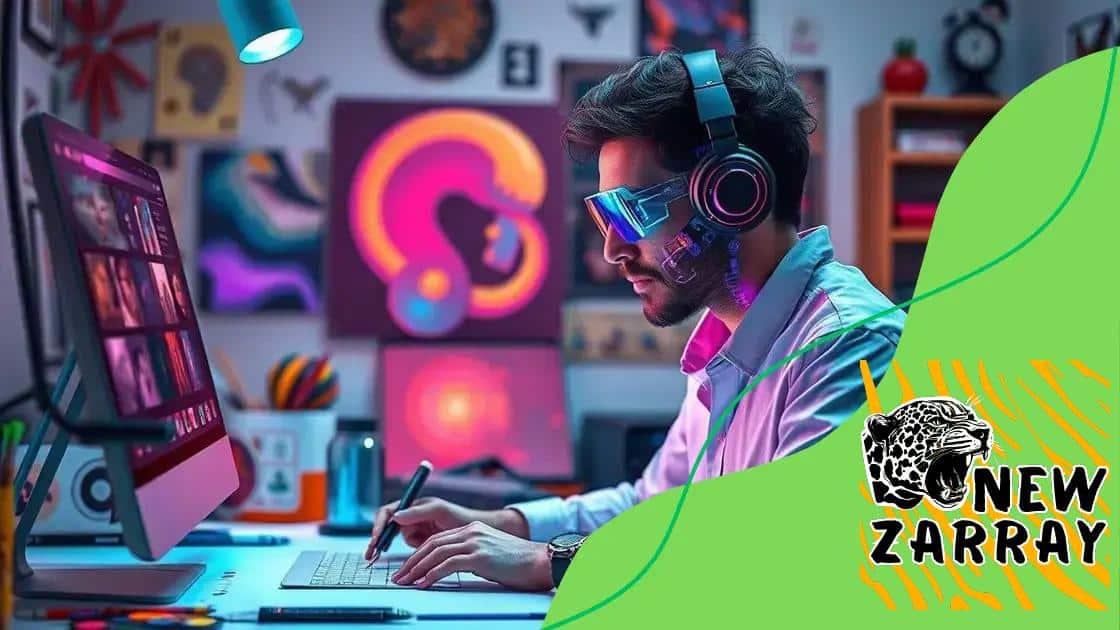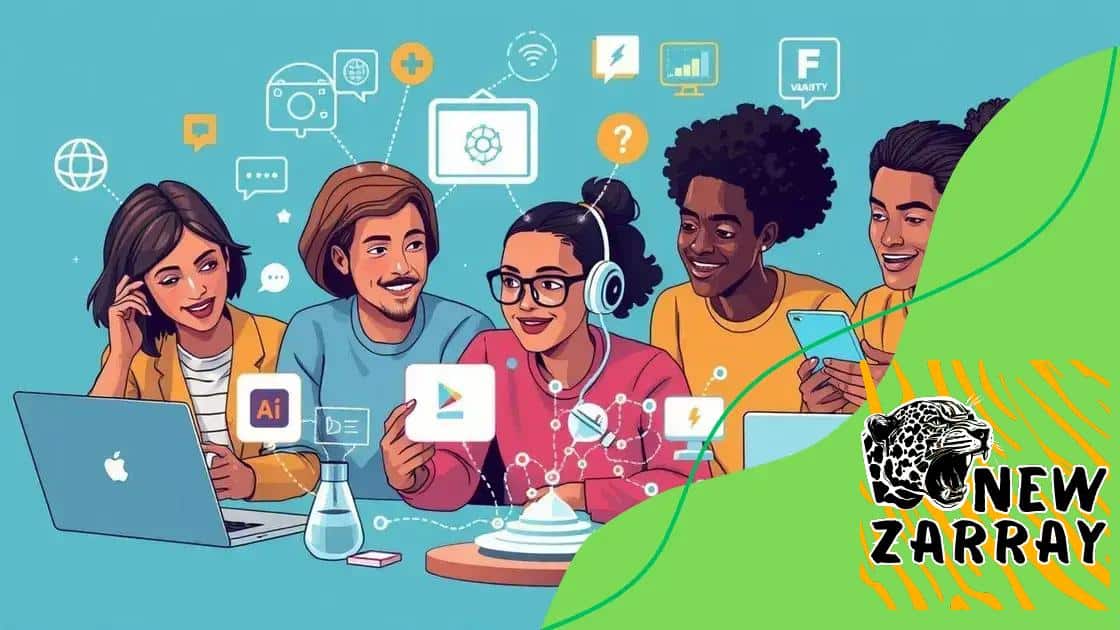The role of AI in transforming the creative industries

The role of AI in transforming the creative industries involves enhancing creativity, personalizing content, and streamlining processes, while also presenting challenges such as resistance to change and learning curves.
The role of AI in transforming the creative industries is becoming increasingly important as technology evolves. Have you ever wondered how AI tools might enhance your creative process or inspire new ideas? Let’s dive into this fascinating topic.
How AI enhances creativity in various fields
AI is reshaping creativity in numerous fields, including art, music, and design. By leveraging sophisticated algorithms, creators can explore new artistic dimensions that were previously unimaginable. Have you ever thought about how technology can inspire innovation in your creative process?
AI’s Role in Artistic Creation
In many creative industries, AI acts as a partner rather than a competitor. For artists, AI tools offer new ways to brainstorm ideas and visualize concepts. This technology can analyze trends and styles, helping artists find unique inspirations that blend tradition with modernity. AI can even generate original pieces based on parameters set by the creator.
Benefits of Using AI in Creative Processes
- Efficiency: AI can automate repetitive tasks, allowing creators to focus on their core ideas.
- Collaboration: AI can work alongside human creators, offering suggestions that enhance the creative process.
- New Horizons: The possibilities of what can be created expand with AI, pushing the boundaries of imagination.
- Customization: AI tools allow for a high degree of personalization, catering to individual artistic styles.
Furthermore, in the music industry, AI analyzes thousands of songs to create new compositions. This means artists can experiment with various genres and styles, enriching their creations. Imagine having a digital assistant that helps you find the perfect melody for your next song! Each note and beat can be tailored to enhance your artistic vision.
Designers are also finding new ways to incorporate AI into their workflow. Through tools that predict trends, designers can stay ahead of the curve, making informed decisions about colors, styles, and layouts. AI can help create prototypes rapidly, allowing for quick iterations and refinements.
As we move forward, the integration of AI in creativity seems limitless. It’s exciting to envision a future where artists, musicians, and designers collaborate with advanced technology, leading to innovations that inspire future generations.
Examples of AI applications in art and design
AI is making waves in the world of art and design, offering artists and designers new tools to express their creativity. As innovators harness the power of artificial intelligence, they are discovering unique ways to blend technology with traditional techniques.
AI in Visual Arts
Many artists are utilizing AI software to generate unique images and artworks. Programs like DALL-E and DeepArt transform simple sketches into intricate pieces by learning from vast datasets of existing art. This technology allows creators to experiment with different styles and ideas effortlessly.
AI-Driven Design Tools
In the realm of design, tools powered by AI are revolutionizing how products are conceived. For instance, platforms like Canva use AI to suggest layouts, color palettes, and design elements tailored to the user’s needs. This empowers designers to create professional-looking graphics with ease.
- Interactive Installations: AI enables the creation of interactive art installations that respond to viewer input, making the experience dynamic and engaging.
- Generative Art: Artists are now creating generative artworks where algorithms dictate the design, resulting in unique pieces each time.
- Fashion Design: In fashion, AI analyzes trends to predict what designs will be popular, helping designers stay ahead of the curve.
- Virtual Reality: AI is enhancing virtual reality environments, offering immersive artistic experiences that blend the digital and physical worlds.
Moreover, AI tools assist in the creative process by analyzing color theory and composition, suggesting improvements that can enhance an artist’s vision. As technology advances, artists are not just using tools; they are collaborating with AI to push boundaries and explore new frontiers within their work.
With the integration of AI in art and design, we see an exciting future where collaboration between human creativity and machine intelligence leads to groundbreaking innovations.
The impact of AI on content creation processes

The impact of AI on content creation processes is profound and transformative, influencing how creators produce and distribute their work. With AI, writers, bloggers, and marketers can streamline their workflow, enhancing both productivity and creativity.
Streamlining Content Production
AI tools help automate repetitive tasks such as data analysis and keyword research, allowing content creators to focus on developing engaging narratives. For instance, AI-driven platforms can suggest trending topics based on real-time data, making it easier for writers to stay relevant and capture audience interest.
Enhancing Personalization
Moreover, AI aids in personalizing content for different audiences. By analyzing user behavior and preferences, AI systems can suggest tailored content that resonates with specific demographics. This targeted approach helps increase engagement rates and build stronger connections with readers.
- Content Optimization: AI tools can optimize written content for SEO by analyzing competitive articles and suggesting improvements.
- Image and Video Generation: AI can also create visuals and videos to complement written content, enriching the overall experience.
- Grammar and Style Checking: Automatic editing tools help ensure that the content is polished and professional, catching errors that might go unnoticed.
- Real-time Feedback: Creators can receive instant feedback on their work, allowing for quick adjustments and refinements.
The integration of AI transforms the way content is not only created but also consumed. Tools powered by machine learning offer insights into what types of content perform well, helping creators refine their strategies. By understanding audience reactions and preferences, writers can craft stories that resonate more deeply with their target markets.
As AI technology continues to evolve, we can expect even more innovative solutions for content creation, leading to greater efficiency and more compelling storytelling. The fusion of human creativity and AI-driven tools opens doors to limitless possibilities in the world of content creation.
Challenges faced by creatives when adopting AI
As creatives embrace AI, several challenges arise that can hinder their ability to fully integrate this technology. Understanding these challenges can help artists, writers, and designers navigate the evolving landscape of creativity.
Resistance to Change
One of the most significant hurdles is the resistance to change. Many creatives are accustomed to traditional methods and may fear that AI will overshadow their unique style. Overcoming this mindset is crucial for growth and innovation.
Learning Curve
The learning curve associated with using AI tools can be steep. Creatives may need to spend considerable time mastering new software and understanding how to effectively use AI in their workflows. This investment in time and effort can feel daunting, especially for those who are already busy.
- Technical Issues: Creatives encounter various technical issues, from software glitches to hardware limitations, that can disrupt their creative process.
- Quality Concerns: Some individuals may worry that AI-generated content lacks the emotional depth and originality that human creators provide.
- Ethical Dilemmas: Issues such as copyright and authorship can arise when AI generates art or text, raising questions about ownership and credit.
- Integration Challenges: Fitting AI tools into existing workflows can be difficult, especially when teams have established processes that are resistant to change.
Additionally, the constant evolution of AI technology can leave creatives feeling overwhelmed. Staying up-to-date with the latest advancements is essential but can be challenging in an already fast-paced industry. As AI continues to develop, these challenges may evolve as well, requiring ongoing adaptation.
Despite these obstacles, many creatives find that embracing AI can lead to enhanced productivity and innovation when approached with an open mind. By addressing these challenges head-on, artists and designers can harness the full potential of AI while maintaining their unique voice.
Future trends: AI’s evolving role in creative industries
The future trends surrounding AI’s evolving role in creative industries are exciting and full of potential. As technology continues to advance, it will shape how artists, designers, and creators work. Embracing these changes can lead to innovative ways of expressing creativity.
Increased Personalization
One significant trend is the increasing personalization of content through AI. As algorithms become more sophisticated, they will analyze user preferences on a deeper level. This allows creators to produce tailored content that resonates with specific audiences, improving engagement and satisfaction.
Collaborative AI
Another emerging trend is the rise of collaborative AI. Instead of merely following commands, future AI tools will work alongside human creators, offering suggestions and enhancing creative processes. This collaboration will likely spark new ideas and foster creativity.
- Augmented Reality: AI will propel augmented reality experiences, enabling immersive storytelling in art, advertising, and entertainment.
- Data-Driven Decisions: AI will analyze vast amounts of data to guide creatives in their decisions, predicting what styles or topics will resonate.
- Innovation in Art Forms: New art forms, such as AI-generated music or virtual installations, will emerge, expanding the boundaries of creativity.
- Accessibility of Tools: As AI technology becomes more affordable and user-friendly, a larger group of people will have access to creative tools, democratizing art and design.
Furthermore, AI’s role in automating administrative tasks will allow creatives to focus more on their art rather than logistics. This shift can lead to increased productivity and inspiration. For instance, AI could manage marketing and social media strategies, enabling artists to devote more time to their craft.
As AI evolves, conversations about ethics and responsibility will also take center stage. Creators must consider issues like authenticity, ownership, and the impact of AI on traditional art forms. Addressing these topics will be crucial in shaping a healthy creative ecosystem.
In conclusion, embracing AI in the creative industries opens exciting possibilities for the future. By understanding and overcoming challenges, creatives can harness the potential of AI to enhance their work. As technology evolves, collaboration between human creativity and artificial intelligence will drive innovation and personalization. Fostering an open mindset can lead to new artistic expressions and greater audience engagement. As we look ahead, staying informed and adaptive will be key to thriving in this ever-changing landscape.
FAQ – Frequently Asked Questions about AI in Creative Industries
How can AI enhance creativity in art and design?
AI tools can provide new inspirations, automate repetitive tasks, and suggest unique combinations of styles that enhance creative output.
What challenges do creatives face when adopting AI?
Creatives often struggle with resistance to change, a steep learning curve, and concerns about the authenticity of AI-generated work.
How does collaboration with AI improve content creation?
Collaboration with AI can lead to new ideas, increased efficiency, and personalized content, ultimately enhancing audience engagement.
What are the future trends for AI in the creative industries?
Future trends include increased personalization, collaborative AI, innovative art forms, and greater accessibility to creative tools.





